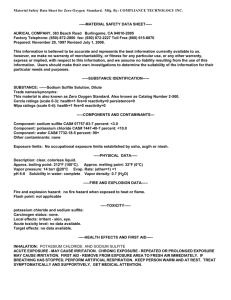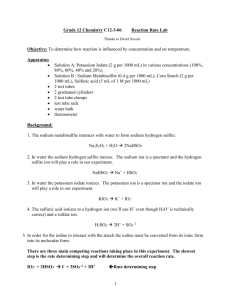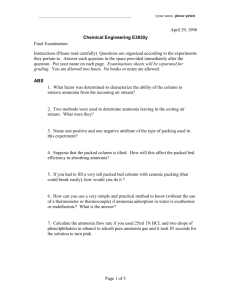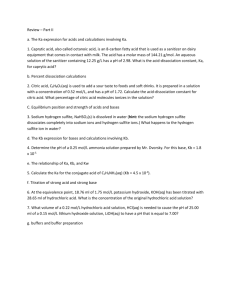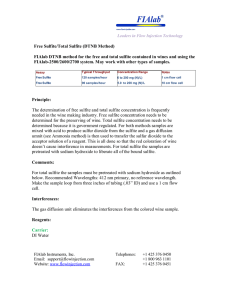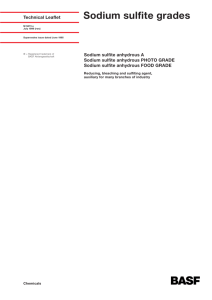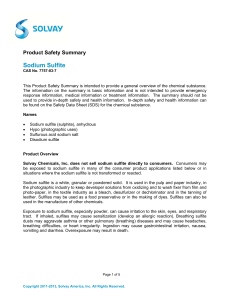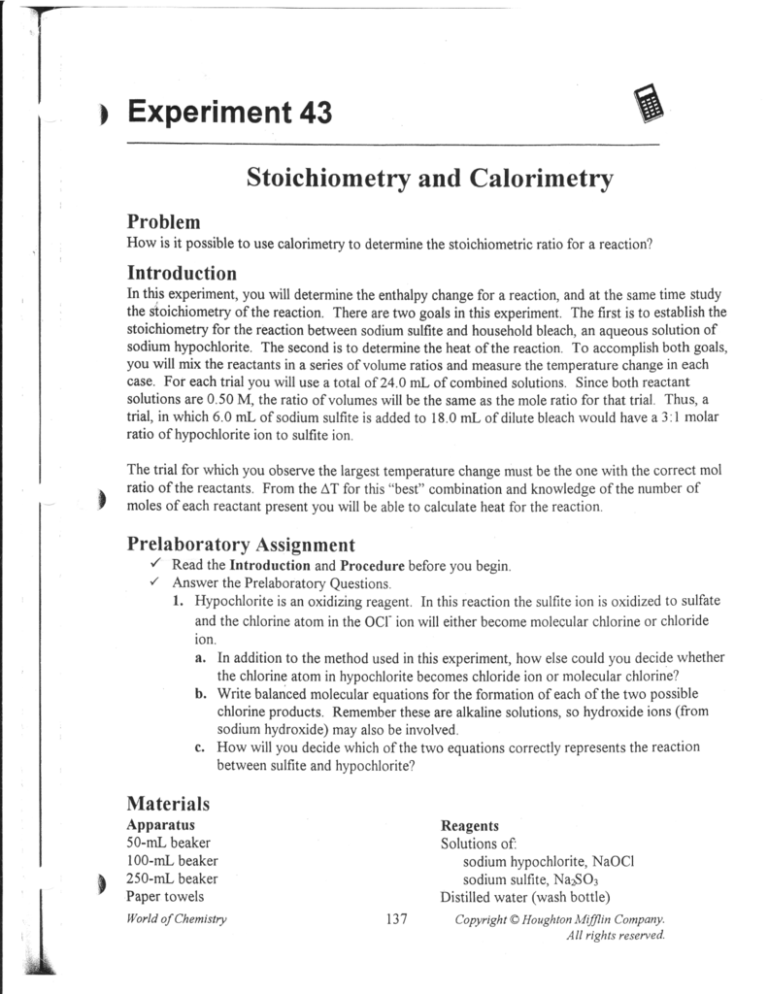
T Experiment 43
Stoichiometry and Calorimetry
Problem
How is it possible to use calorimetry to determine the stoichiometric ratio for a reaction?
Introduction
In this experiment, you will determine the enthalpy change for a reaction, and at the same time study
the stoichiometry of the reaction. There are two goals in this experiment. The first is to establish the
stoichiometry for the reaction between sodium sulfite and household bleach, an aqueous solution of
sodium hypocilorite. The second is to determine the heat ofthe reaction. To accomplish both goals,
you will mix the reactants in a series of volume ratios and measure the temperature change in each
case. For each trial you will use a total of 24.0 mL of combined solutions. Since both reactant
solutions are 0.50 M, the ratio of volumes will be the same as the mole ratio for that trial. Thus, a
trial, in which 6.0 mL of sodium sulfite is added to 18.0 mL of dilute bleach would have a 3:1 molar
ratio of hypochlorite ion to sulfite ion.
.L
ps
The trial for which you observe the largest temperature change must be the one with the correct mol
ratio of the reactants. From the AT for this "best" combination and knowledge of the number of
moles of each reactant present you will be able to calculate heat for the reaction.
Prelaboratory Assignment
/
r'
Read the
Introduction
and Procedure before you begin.
Answer the Prelaboratory Questions.
1. Hypochlorite is an oxidizing reagent. In this reaction the sulfite ion is oxidized to sulfate
and the chlorine atom in the OCI- ion will either become molecular chlorine or chloride
ion.
a, In addition to the method used in this experiment, how else could you decide whether
the chlorine atom in hypochlorite becomes chloride ion or molecular chlorine?
b. Write balanced molecular equations for the formation of each of the two possible
chlorine products. Remember these are alkaline solutions, so hydroxide ions (from
sodium hydroxide) may also be involved.
c. How will you decide which of the two equations correctly represents the reaction
between sulfite and hypochlorite?
Materials
Apparatus
50-mL beaker
$
Reagents
Solutions of:
sodium hypochlorite, NaOCI
sodium sulfite, NafO:
Distilled water (wash bottle)
100-mL beaker
250-mL beaker
Paper towels
World of Chemistry
137
Copyright
@
Houghton &v{ffiin Company.
All rights reserved.
Foam polystyrene cups, 6-az (2)
25-mL graduated cylinders (2)
Thermometer or CBl-interfaced probe
Safety goggles
Lab apron
sarery
1.
2,
*1P 4*
Wear safety goggles and a lab apron whenever you are working in the laboratory.
Sodium hypochlorite is a skin irritant. Avoid contact with skin.
Procedure
l.
Prepare the calorimeter set-up as illustrated in X'igure 1. The system consists of a 50-mL beaker,
wrapped in paper towel for insulation, then inserted into a 100-mL beaker. The lid is an inverted
6-oz expanded polystyrene cup; the probe or thermometer is inserted through the base of the cup,
as shown in Figure l.
n
li--"
Probo or lhermornster
li
''-ii--trrr)
i -"'--*.'--
i
li
t\
i
1
---.6
oz. foam cuP
lh
r"
\-.
ii
-"2___-.t oo mt beaker
hl*:_.*.ll --'*:Fi"'"- ll
Probe or -X1Alo"_Jl--. s0 mt beaker
I
ti'rermometer
lt tf=*l#;l---{i--*
il
PaPer lowel
ll ti :ili
lj
(wranned around
,4.
'_J
ll '-'i
\._::Y':..,, rheb€aker)
I
Figure L
Apparatus for measuring temperature ch4nge during the reaction
Notes
,/
:
If a computer- or CBl-interfaced prope is used, it may !e necessary to use a larger cup for the lid,
trimmed to fit more closely to the top of the beakers. Most interfaced thermistor probes have bushings
{
that can be used to make a good seal with the cup.
If a standard glass tlprmometer is used, drill a small hole in the cup using a #2 cork borer. Do this very
{
{
carefully, since a snug fit is essential for good results.
A digital thermometer generally has a pointed tip which can be used to make its own opening.
Regardless of the qrye of temperature senFor used, onca it is in place it should not be removed so that the
opening is not widened, thus reducing heat-retention.
2.
Label separate 25-mL graduated cylinders for the two reactant solutions, NaaSOg and NaOCl,
Keep these two separate to avoid contamination.
World af Chemistry
138
Copyright
@
Houghton
Mffiin
Company.
All rights reseryed,
3. Eacll irial"follows the same basic sequence:
a. Always place the reactant solution for which the volume is larger in the calorimeter first. It is
lgcefary do this so that the thermometer or temperature probe is completely submerged.
-b. The
lid containing the
c.
thermometer or probe is placed on ih. calorimeter and the temperature
of the solution is recordecl.
The lid is removed and the second reagent is added all at once. Thelid, containing the
thermometer or probe, is immediately ieplaced and the calorimeter system is gently swirled to
ensure complete mixing.
r'
r'
The lid is removed and the contents of the system are rinsed down the drain.
The inner beaker of the calorimeter is rinsed with distilled water and dried, in preparation
for the next trial.
Mixing Volumes
Trial
1
2
3
4
5
6
7
sodium
hypochlorite
18.0 mL
16.0
l4-4
12.0
9.6
8o
60
sodium
sulfite
6.0 mL
8.0
9.6
l\ote:
14,5: 9.5 is close enough
t2.0
r4,4
16.0
19 0
$
Cleaning Up
L. All solutions remaining after the reaction may safely be poured down the drain.
2. Clean all glassware and return it to its proper location.
3. Your teacher will instruct you about what to do with the foam cups and CBL apparatus.
4, Wash your hands thoroughly before leaving the laboratory.
Analysis and Conclusions
Complete the Analysis and Conclusions section for this experiment either on your Report Sheet or
in your lab report as directed by your teacher.
If Vgy are not using a Report
headings:
Trial
l,ttorld of Chemistry
Sheet for this experiment design a Summary table
Mol OCI/mol SOr'-
139
q (J)
with the following
I
Copyright @ Houghton
Mffiin
Company.
AII rights reserYed.
your result in the
For each trial calculate q, the quantity of heat released by the reaction and enter
specific heat as
Summary Table. Assume that each of the solution combinations has the same
water, 4-.1g4 J/g"C, Note: The total mass of solution being heated is 24.0 g in each case.
mole ratio that produces
2, To determine the stoichiometry of this reaction we need to establish the
the maximum amount of heat.
a. Use the volume and concentration of sodium sulfite to calculate the number of moles of
sulfite ion present in each reaction system.
b. IJse the numbers of moles just calculated and the value of q for each reaction (from 1) to
the
calculate values of AH for each reaction in kJ/mol NazSOr. Record these values in
1.
3.
Summary Table.
Based on your answer to 2b, which combination produced the greatest amount of heat
per mole of sodium sulfite consumed? This must be the reaction combination that is closest to
ratio
ihe actual stoichiometry of the reaction. Write the equation for the reaction using the mole
of sodium hypochlorite to sodium sulfite that matches your experimental result' To complete
the balancing you may need to add hydroxide ions and/or water to one side or the other.
Something Extra
L. you were told to base your decision on the number
2.
of moles of sodium sulfite consumed. That
would be
was an arbitrary choice. Do the calculations necessary to show that the same results
obtained and the same decision would have been made had you based your calculations in
2b on the moles of sodium hypochlorite consumed, instead of on moles of sodium sulfite.
Repeat the experiment, using ihe same concentrations and volume combinations, but replace
the sodium sulfite with either
a. sodium thiosulfate, Na2S2O3, or
b. sodium iodide. Follow the instructions for the original experiment'
World of Chemistry
140
Copyright
@
Mffiin ComPanY.
All rights reserYed,
Houghton
$)

